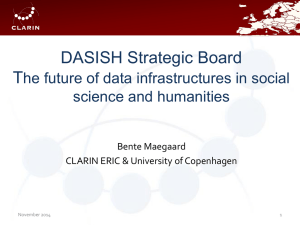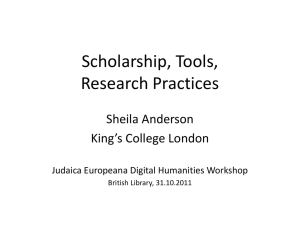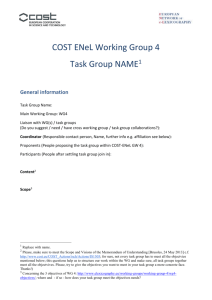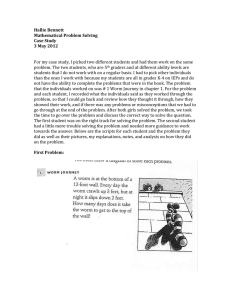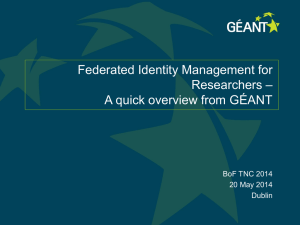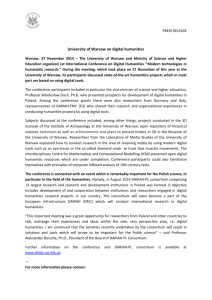Digital Research Infrastructure for the Arts and Humanities: DARIAH King’s College London
advertisement
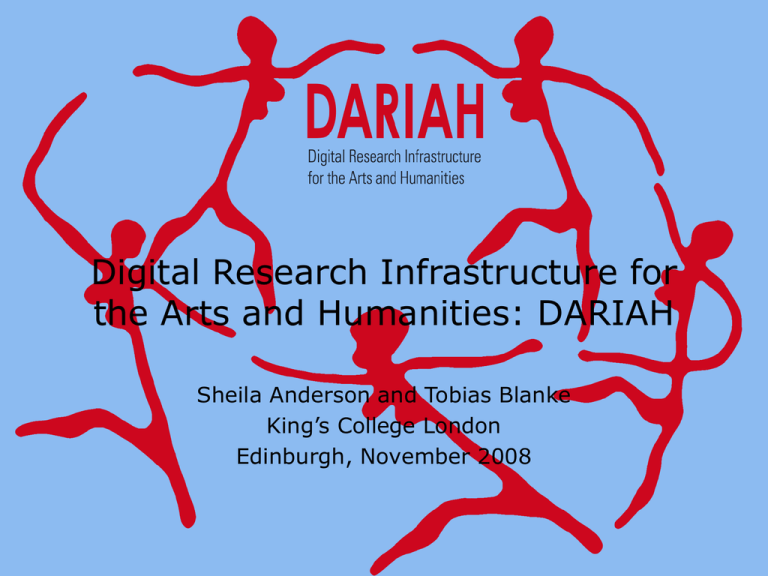
Digital Research Infrastructure for the Arts and Humanities: DARIAH Sheila Anderson and Tobias Blanke King’s College London Edinburgh, November 2008 ESFRI Aurora Borealis HiPER www.dariah.eu Social Sciences and Humanities (SSH) • European activities are until now funded on a project basis and carried out as voluntary activities within a local context • Stable, pan-European data infrastructures for the humanities hardly exist • Increasing internationalisation of humanities research puts new requirements for such infrastructures www.dariah.eu CLARIN SHARE EROHS Not funded CESSDA ESS DARIAH DARIAH content domains Peter Doorn, DANS www.dariah.eu Two A&H Projects funded:CLARIN and DARIAH • Funded through EC Framework 7 • CLARIN is committed to establish an integrated and interoperable research infrastructure of language resources and its technology. • Build on the successful DAM-LR project virtualising collection access and securing it via Shibboleth Contact: http://www.mpi.nl/clarin/ www.dariah.eu UK Involvement: King’s College London, University of York, and University of Oxford Strategic WP: Sheila Anderson + Seth Denbo functional specifications and strategic vision Technical Reference Architecture WP: Tobias Blanke + Research Associate together with the Conceptual Modelling WP responsible for developing a virtual repository, middleware, services and toolkit; work with ADS at York Communications and Liaison with Clarin: Martin Wynne ensure complementarity between the two humanities project www.dariah.eu DARIAH Vision to facilitate long-term access to, and use of, all European humanities and cultural heritage digital information www.dariah.eu Just like astronomers require a virtual observatory, researchers in the humanities need a digital infrastructure to study the sources that are until now hidden and often locked away in cultural heritage institutions. (…). The Research Infrastructure (RI) proposed here would seek to take significant small steps towards achieving this grand vision for European humanities and cultural heritage information. www.dariah.eu Challenges Nature of Developments to date • Project based, highly dispersed, little or no long term funding National environments • organisational contexts, legal environments, legacy systems, ... Heterogeneous usage • communities and their scholarly processes, data types, ... Creating network effects • storage pools, semantic interoperability, seamless access www.dariah.eu DARIAH Concept www.dariah.eu www.dariah.eu So far, so good? ESFRI Definition 'The term e-Infrastructure is used to indicate the integrated ICT-based Research Infrastructure in Europe. The e-Infrastructure viewpoint allows to join and fit all interrelated infrastructures together and start think of them as a system – and optimize not for each individual part, but for the whole. The prime goal of the eInfrastructure may be to support […] ALL KINDS OF E-s. Also from traditionally less computer-oriented areas such as the social sciences, the humanities and biodiversity there is a strong trend towards mass deployment of ICT to manage the large variety of decentralized data sources and find novel approaches to traditional problems. Key components of the e-infrastructure are networking infrastructures, middleware and organization and various types of resources.' www.dariah.eu But where is the Researcher? ESFRI Definition 'The term e-Infrastructure is used to indicate the integrated ICT-based Research Infrastructure in Europe. The e-Infrastructure viewpoint allows to join and fit all interrelated infrastructures together and start think of them as a system – and optimize not for each individual part, but for the whole. The prime goal of the eInfrastructure may be to support […] ALL KINDS OF E-s. Also from traditionally less computer-oriented areas such as the social sciences, the humanities and biodiversity there is a strong trend towards mass deployment of ICT to manage the large variety of decentralized data sources and find novel approaches to traditional problems. Key components of the e-infrastructure are networking infrastructures, middleware and organization and various types of resources.' … and the user by supporting the whole research life cycle in a digital age www.dariah.eu Placing the Researcher at the Centre What kinds of data do researchers produce and use? They use things like … www.dariah.eu From the AHDS archives ... Museum of London Archaeological Archive New Survey of London Life and Labor, 1929-1931 London College of Fashion: The Woolmark Company www.dariah.eu From the AHDS archives ... Museum of London Archaeological Archive New Survey of London Life and Labor, 1929-1931 Can there ever be one infrastructure to work London College of with Fashion: The Woolmark all these data items? Company www.dariah.eu Placing the Researcher at the Centre What do researchers do to work with their source data? They build things like … www.dariah.eu Virtual Workbench www.dariah.eu Virtual Workbenches www.dariah.eu Virtual Vellum www.dariah.eu Data Services for Associated Motion capture User Categories - CultureLab www.dariah.eu An architecture of participation People, communities, organisations, content, tools, services, methods…….. DARIAH Vision Revisited to facilitate long-term access to, and use of, all European humanities and cultural heritage digital information for the purposes of research www.dariah.eu For Further Information • See www.dariah.eu • Talk to Sheila, Seth or Tobias • For CLARIN speak to Martin www.dariah.eu
